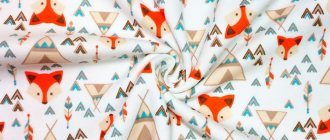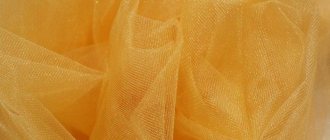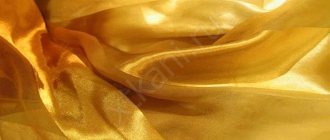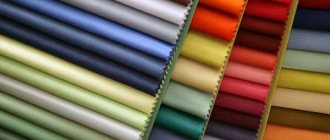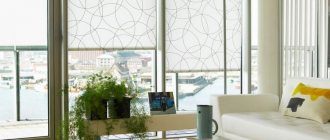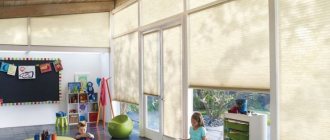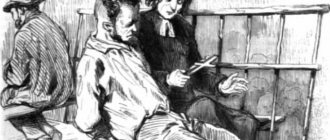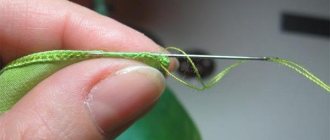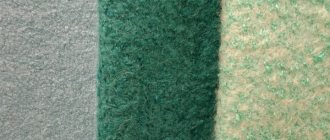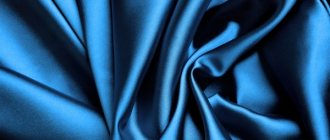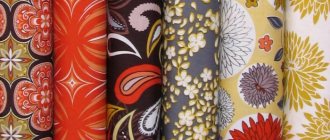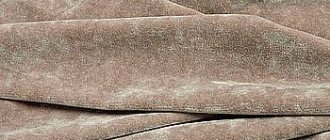This is a surprisingly light material that folds beautifully. The name of the fabric gas personifies its airiness, transparency, weightlessness. In fact, the fabric got its name from Gaza, the ancient city of Palestine, where it was first made. True, in some sources one can find references to the (etymological) dictionary of M. Fasmen, according to which the word gaze (French) comes from the Arabic name for raw silk, which sounds like “ḳazz”.
Structure and properties
Although the name of this material is directly associated with its characteristics, it is believed that it is associated with Gaza, the center of production. This category includes textiles made of cotton or silk of any weave (plain, satin, twill), if it meets two conditions:
- use of fibers no more than 120 number (most often twisted);
- loose fit of the warp to the weft.
This fabric is transparent and very light. Depending on the composition and texture of the fibers, fabric gas is divided into the following types:
- tarlatan - soft cotton or half-silk fabric, which is starched to add volume;
- illusion - a very transparent material made of especially thin threads;
- crystal - fabric with color tints due to different shades of warp and weft;
- rice is a flowing fabric made from raw silk that has not been twisted;
- Marabou is a rather rigid golden material made from raw silk that holds volume well.
The advantages of these types of gas include, first of all, their naturalness. They are hypoallergenic, breathable and absorb moisture, prevent the proliferation of microorganisms, and most importantly, they are very beautiful and truly feminine. Their disadvantages include low strength and easy stretching of threads.
This is interesting: Chenille fabric is what kind of material it is: for upholstery, curtains. Photo and description of characteristics
Fabric gas: composition, application, properties
| This article lacks links to sources of information. | |
| Textile | |
| Woven | Satin • Barathea • Baptiste • Bombazine • Canvas • Calico • Gabardine • Gas • Grenadine • Denim • Donegal • Dragette • Drape • Glued fabric • Calico • Cordura • Crepe • Cretonne • Loden • Bast fabric • Madapolam • Gauze • Moquette (upholstery fabric) ) • Moleskine • Muslin • Oxford • Organza • Percale • Poplin • Ripstop • Matting • Twill • Satin • Chintz • Taffeta • Tweed • Braid • Teak • Toile • Failure • Flannel • Habutai • Canvas • Cheviot • Chiffon • Pongee |
| Woven decorative | Damask • Leatherette • Camlot • Lame • Brocade • Songket • Tulle |
| Woven pile | Velvet • Corduroy • Cord • Crimplene • Terry • Plush • Chenille • Broadcloth • Fleece |
| Non-woven | Felt • Flock • Interlining |
| Knitwear | Boiled wool • Velor • Jersey • Pique |
| Lace | Mesh (fabric) • Tulle |
| Technical | Belting • Tarpaulin • Banner fabric • Calico • Thermolin • Carbon fiber • Serpyanka |
| Trademarks™ | Cordura • Coolmax • Dacron • Gore-Tex |
| Ornaments | Argyle • Herringbone • Houndstooth • Tartan • Paisley |
| Materials | Acrylic • Alpaca • Angora • Viscose • Jute • Cashmere • Kevlar • Coconut • Hemp • Linen • Microfiber • Sea silk • Mohair • Nylon • Polyester • Ramie • Sisal • Cotton • Silk • Wool • Elastomer |
| Finishing | Batik • Calendering • Dyeing • Mercerization • Moiring • Pressing • Sanforization • Textile printing |
Wikimedia Foundation. 2010.
See what “Gas (fabric)” is in other dictionaries:
GAZ (fabric) - GAZ (French gaze), a light translucent fabric of a special gas weave, in which the finest silk or cotton threads are arranged so that space is maintained between the weft and warp threads. The weaving method determined the type of gauze... ... Encyclopedic Dictionary
Gas (fabric) - see Cotton. fabrics and Gas fabrics ... Encyclopedic Dictionary F.A. Brockhaus and I.A. Efron
gas - 1. gas/¹ (substance). 2. gas/² (fabric) ... Morphemic-spelling dictionary
GAZ - (French gaze). Lightweight transparent fabric made of silk or linen; got its name from the Syrian mountain. Gaza, where it was first prepared. Dictionary of foreign words included in the Russian language. Chudinov A.N., 1910. GAZ (French gaz, from German gaschen ... Dictionary of foreign words of the Russian language
GAZ-21 - GAZ 21 ... Wikipedia
gas - 1. GAS, a ( y), prev. on gas; (colloquial) on gas; m. [French] gaz] 1. The physical state of a substance in which its particles (atoms and molecules) move freely and have the ability to spread and fill the available space; substance ... Encyclopedic Dictionary
Gas (meanings) - Gas: Gas is the state of aggregation of a substance. Gas is a colloquial term for natural gas and its supply systems. Gas light transparent fabric. GAZ is an abbreviation for Gorky Automobile Russian... ... Wikipedia
GAZ - 1. GAZ1, gas, male. (French gaz; word invented in the 17th century by the Belgian physicist Van Helmont). 1. A physical body in a special state in which it strives to evenly fill the entire internal volume of the space in which it is contained.... ... Ushakov's Explanatory Dictionary
GAZ - 1. GAZ1, gas, male. (French gaz; word invented in the 17th century by the Belgian physicist Van Helmont). 1. A physical body in a special state in which it strives to evenly fill the entire internal volume of the space in which it is contained.... ... Ushakov's Explanatory Dictionary
GAS - or gas. airy liquid, body or substance, in the form of air. Bodies in general are: solid, liquid, steam, gas, and maybe also ethereal, weightless. | The lightest, thinnest, rarest silk fabric for women's clothing. Others in the first meaning ... Dahl's Explanatory Dictionary
Historical information, creation process
Considering the question of what gauze fabric is, it is necessary to note that it first came to Europe in 1560, and already at the end of the 19th century it became very popular. Gas began to be used to sew ball gowns on satin or satin covers. This was true in the days of balls, but now it is no longer so common. In the modern world, gas fabric has found application. It can often be found in a store called Margilan silk.
True ghaz fabric, which came from Palestine, is characterized by a very special weave. One weft thread is typically intertwined with two warp threads. This weaving began to be called gauze in honor of this fabric. But in stores you can see fabrics of different weaves, which are also called gas. They are considered to be variations of the original.
Types of weaving used:
- Satin. With this interweaving of threads, it is possible to form a shiny, perfectly smooth surface.
- Twill. This weaving is distinguished by its characteristic rib, which has a diagonal direction.
- Linen. This is a classic chess weave.
All fabrics in the gas series are woven without special compaction, which is why it is possible to make them so translucent and light.
All about felt: types, features, properties and application of the material
Fabric reviews
Natalya: “We use gas to finish costumes at a dance school. The swimsuit itself is stretch, and the skirts are made of several layers of multi-colored gauze. It turns out beautifully, the material is lush and does not sag. And it’s easy to do, we can do it on our own, without involving seamstresses.”
Lena: “I rarely use gas in my products, but with pleasure. It makes excellent draperies for blouses. Sometimes dresses are ordered with it: a satin cover at the bottom, and gasket on top. I only had to sew skirts with this kind of trim a couple of times, and those were for children for photo shoots.”
To follow the release of new articles, add our site to your browser bookmarks! Read on to learn how to remove machine oil stains.
Properties of materials. Advantages and disadvantages
The advantages include:
- hypoallergenic. Does not cause an allergic reaction or irritation on the skin;
- air permeability. Both the specifics of the weave and the real fibers themselves breathe freely, allowing the skin to breathe;
- antibacterial. Silk has antibacterial characteristics, and cotton is considered an unfavorable environment for the activity of harmful microorganisms;
- ease. The canvas comes out almost weightless and even with multi-layered costumes the weight is not felt;
- visual qualities. The material is good both on its own and as a companion, it is perfectly combined with many other materials, and is excellently used in a multi-layered version;
- versatility of application. Different types of gas behave differently - for example, a harsh marabou perfectly holds its shape and forms a lush drapery, while delicate rice forms soft waves of upholstery, creating a flowing effect;
- ease of care. You can take care of the products at home.
Among the bad qualities - perhaps only fragility and instability to the influences of mechanics - because the threads do not fit tightly together, hooks easily appear on the surface, and the unusual thinness of the yarn does not help the strength of the finished fabric.
Peculiarities
To produce gas fabric, processed silk or raw silk is used. This definition is common to all types of this matter, but each of them can be considered separately:
- Tarlatan. Rigid fabric, which is associated with strong starching. To make it, pure cotton or a combination of it and half silk is used. The coating holds its shape very well until washed off.
- Marabou. This is a slightly stiff material due to the use of twisted yarn to create it. The characteristic color is golden. It holds its shape very well, so it is great for creating voluminous draperies. Raw silk is used for production.
- Crystal. This is a soft and thin material. Threads of different colors are used for the weft and warp, which gives the fabric an iridescent effect.
- Gas-rice Soft, delicate, flowing fabric that falls in soft lines. It is made from untwisted raw material, which allows it to achieve incredible thinness.
- Illusion. This is the thinnest of all the materials presented, which is distinguished by its airiness.
- Shanbury. This is a gauze fabric, which includes satin stripes, complemented by embroidery. Severe. Durable material used primarily for technical purposes.
- Gas chiffon. It has much in common with regular chiffon, but is distinguished by its thinness and ability to fall in soft lines and waves. It has a rough surface and lacks shine. Processed silk is used for production.
Crepe de Chine fabric - what kind of fabric, composition and properties
Gas fabric – special weave
This is a surprisingly light material that folds beautifully. The name of the fabric gas personifies its airiness, transparency, weightlessness. In fact, the fabric got its name from Gaza, the ancient city of Palestine, where it was first made. True, in some sources one can find references to the (etymological) dictionary of M. Fasmen, according to which the word gaze (French) comes from the Arabic name for raw silk, which sounds like “ḳazz”.
History of fabric, manufacturing process
Gas came to Europe around 1560 and by the end of the 19th century it gained popularity: ball gowns with covers (satin or satin) began to be made from it. The time for balls has passed, and this material is no longer found in the closets of fashionistas so often. However, in the modern world it still has applications. In sewing stores it is sometimes found under another name: Margilan silk.
Real, light fabric - gaz, which came to us from the environs of Palestine, has a special weave: 1 weft thread is intertwined with 2 warp threads. And it has a corresponding name: gas. However, under the same name in stores you will find fabrics woven using a different principle and considered variations of the original.
Types of weaving:
- Satin, forming a perfectly smooth, shiny surface.
- Twill, with its characteristic rib, directed diagonally.
- Plain, with a classic checkerboard weave.
All types of gauze are woven without compaction, resulting in the same lightness and transparency.
We recommend reading an interesting article about the advantages of flock fabric, which is completely different from gauze fabric.
Description and characteristics of gas, composition, cost
Thin, almost completely transparent, made from processed silk and raw silk. This is a general definition for all types of gas. Let's look at each of them:
- Marabou. It is a bit harsh due to the fact that twisted yarn is used to make it. The characteristic color is golden. It holds its shape well and is suitable for creating voluminous draperies. Made from raw silk.
- Tarlatan. Hard, but due to strong dressing (starch). Made from pure cotton or its mixture with silk (50x50). It holds its shape well until the dressing is washed off.
- Gas-rice Delicate, soft, flowing, gently falling fabric. Very thin, made of untwisted raw material.
- Crystal. Quite thin and soft. The weft and warp contain threads of different colors, resulting in an iridescent fabric.
Types of material
Gas fabrics are extremely diverse and are divided into types depending on the method of weaving, the characteristics of dyeing and processing of the raw materials. So, the most popular are:
gas-illusion
gas-ris
- Gas is an illusion. It is made from very fine yarn, so it is very thin and transparent.
- Gas - Fig. It is made from raw silk, but the threads used are untwisted. This makes the fabric particularly soft and tender.
gas-marabu
gas crystal
- Gas – marabou. It is also made from raw silk, but the threads used are twisted, so the fabric itself is somewhat stiffer and has a golden appearance, hence the name - this is the color of the plumage of the marabou bird.
- Gas - crystal. For production, threads of different colors are used as morning and warp. Therefore, the canvas is obtained with a multi-colored iridescent sheen.
Application area
Gas is often used for finishing blouses and dresses. Transparent inserts, ruffles, flounces, and bows are made from it. The gas is also suitable for making fabric flowers. They are used to decorate hair clips and other hair decorations.
Summer multi-layer dresses are sewn from gas as an independent material. Usually in a romantic style with soft draperies and a flowing silhouette.
You can sew multi-layer skirts and sundresses from gauze for spring and summer. Models can be in boho, shabby chic, romantic styles. They are comfortable in the heat.
Evening dresses made of gauze can be with satin or silk covers. Then use one layer of translucent fabric.
Gas is also used to finish children's clothing - elegant or casual dresses. You can use it to make skirts and costumes for performances or carnivals.
Gauze fabric is also suitable for wedding dresses. Multilayer skirts are made from it, or the bodice and sleeves are trimmed, or a veil is sewn.
Gas can be used to decorate rooms. In the home interior it is used:
- For sewing daytime curtains.
- Bed canopy.
- Curtains to divide a room into zones.
The material is often used to decorate a wedding venue. Weightless and transparent gas is used to decorate banquet halls and restaurant terraces.
Fabric is actively used in theaters to create scenery and costumes. Concert halls can be decorated with it.
Nets for zoologists or aquarists are made from mill gas fabric. It is used for industrial purposes as a filter.
Mill gas is also used as fabric for sieves. These can be both industrial and household products.
Women's outfits of the mid-19th century
In the middle of the 19th century, the style of dresses began to return to the previously existing fashion. They differed in the following elements:
- high waist;
- the presence of a corset;
- starched bell skirt;
- metal frame;
- cuffs.
With the beginning of Queen Victoria's reign, romantic and dreamy images came into fashion. The outfits acquired pronounced splendor and began to be complemented with original attributes. Dresses of the 19th century were decorated with patterned borders, flounces, and scallops. The hourglass silhouette was popular.
The period of the 60s began to be called the “second Rococo”. Ladies of this time wore elegant caps and hats, muffs and gloves. Clothes were complemented by lace-up boots, shawls, umbrellas and jewelry. A distinctive feature of the costume was the special cut of the sleeves called “leg of lamb”. This is a wide sleeve at the shoulder that tapers from the elbow to the cuff.
In the 50s, a special stiff fabric was used to sew petticoats, which was made from whalebone or steel wire. Externally, the frame resembled a large bird cage.
In the 70s, ladies began to put a pillow under their hem. This is how they gave their figure splendor. The back of the dress was decorated with draperies, ruffles and folds in order to visually enlarge the buttock area. A neckline was in fashion, which women covered during the day with scarves or shawls. They showed a deep neckline during an evening outing.
What to sew from transparent material?
In the East, gas was used for curtains, canopies, transparent bedspreads, and also for clothing. In Europe, this fabric was seen in the 16th century, but its popularity began to flourish two centuries ago, when transparent empire-line dresses and light bedspreads came into fashion. Gas has become a favorite material for ballroom and wedding dresses, trimming dresses and hats . The fashion for it lasted for almost a century, since the transparent fabric on a shiny cover and a variety of draperies were suitable for elegant dresses of any style. Currently, this fabric, although not at the peak of consumer demand, still remains in demand, especially among supporters of natural fibers.
Silk gauze is an elite material and is used for expensive lightweight elegant dresses and wedding dresses.
As a rule, such clothes are sewn on a cover or made multi-layered. This fabric is also used for exclusive home textiles, decoration, and the manufacture of various accessories. Cotton gauze is a more democratic textile that is well suited for beautiful light dresses and blouses, transparent curtains, pareos, scarves and other beautiful accessories. It is also used to make nets for zoological research.
Composition and production process
Gas fabric is a natural openwork fabric; cotton wool and silk are used as raw materials.
The fabric lends itself well to dyeing and comes in a variety of colors
Gas is considered one of the lightest substances. This elegance is achieved due to the special weaving and fineness of the threads (from No. 120 and above).
The threads are not adjacent to one another closely, but are separated by small intervals, as a result of which the fabrics are light and transparent.
There are two types of interlacing of gaseous fabrics, for which the main rule remains not to compact the threads together, these are:
- linen - the simplest type, used in “gaze unie” fabric varieties, in which the warp and weft threads are intertwined with each other in every two successive overlaps;
- gauze - a feature of gauze weave is the combination of two warp and one weft thread, used to produce gauze fabric (fleur) - gaze a tour anglais, patterned gauze.
Weaving threads in simple gauze fabrics
What type of fabric is this
Gas is a lightweight transparent fabric of natural origin (silk or cotton). It is distinguished by a special weave: two warp threads are intertwined with one weft thread (threads located at right angles to the warp) and are not compacted. Due to the space formed between the threads, the material turns out to be soft and translucent.
Fabric gauze: colors
In fabric stores it is sometimes found under the name “Margelan silk”.
Main producers: Italy, Uzbekistan, China and Russia.
Characteristics of the material. Advantages and disadvantages
gas-4
gas-2
The advantages include:
- hypoallergenic. Does not cause allergies or skin irritation;
- breathability. Both the weaving features and the natural fibers themselves allow air to pass freely, allowing the skin to breathe;
- antibacterial. Silk has antibacterial properties, and cotton is an unfavorable environment for the activity of pathogenic microorganisms;
- ease. The canvas turns out to be almost weightless and even with multi-layered outfits the weight is not felt;
- visual qualities. The material is good both on its own and as a companion, combines well with many other materials, and is wonderfully used in a multi-layered version;
- versatility of use. Different types of gas behave differently - for example, harsh marabou holds its shape remarkably well and forms a lush drapery, while delicate rice forms soft waves of drapery, creating a flowing effect;
- ease of care. You can care for the products at home.
Among the disadvantages - perhaps only fragility and instability to mechanical stress - due to the fact that the threads do not fit tightly together, hooks easily appear on the surface, and the exceptional thinness of the yarn does not contribute to the strength of the finished fabric.
Types of gas
Depending on the type of raw material, thread density and weaving method, today fabric is divided into the following varieties:
- marabou – the canvas has a golden hue and drapes well due to its inherent rigidity;
- tartlant - the material is treated with apperet (starch) and has a harsh structure;
- illusion is the most transparent and lightest type of gauze fabric, produced from the thinnest threads;
- rice is a soft and delicate material, made from untwisted raw silk;
- crystal – production is carried out using threads of different shades, which gives the fabric the ability to “shimmer” in color;
- shanbury - a type of gauze fabric in which there are opaque satin stripes, the oldest type, which was invented in the 18th century by French textile workers;
- gas chiffon - has a rough matte surface, which makes it look like ordinary chiffon, and is distinguished by its extraordinary thinness and softness.
In fabric catalogs and stores there is another name for the fabric - “Margilan silk”. This type of gauze fabric is named after the Dagestan city, where the delicate material is now being mass-produced. Margilan silk or harsh gaz:
The price of fabric ranges from 400 to 1500 rubles per linear meter. The cost depends on the country of origin, the thickness of the thread and the raw materials used. For example, 100% silk gauze chiffon can cost about 1000 rubles per 1 meter, and raw chiffon can cost 300-500 rubles.
Description and characteristics of gas
The positive qualities of all types of fabric include:
- breathability – the fabric allows air to pass through freely, allowing the body to “breathe”;
- lightness - the material is practically weightless and even with multi-layered outfits, the weight of the product is not felt;
- hypoallergenic - thanks to the use of natural raw materials, the material, in contact with the body, does not cause allergies or irritations on the skin;
- antibacterial – the composition of the fabric does not allow the proliferation of pathogenic microorganisms;
- attractive visual qualities;
- versatility - allows you to choose fabric for different needs;
- combines well with other fabrics.
- low strength;
- prone to “tightening and snagging” - the threads are easily pulled out when in contact with the serrated surface.
Advantages and disadvantages
Weightless canvas has its advantages and disadvantages, and the advantages significantly outweigh the disadvantages.
Pros:
- lightness, tenderness, softness and airiness of the fabric;
- hypoallergenic;
- breathability;
- spectacular and original appearance;
- naturalness;
- has an antibacterial effect;
- ease of care.
Minuses:
- fragility: like any thin material, gas can easily be caught on something and torn;
- the price of silk fabric can be high.
With careful use, a product made from this unique fabric can last a very long time, since the material does not fade in the sun and does not become unusable due to frequent wear.
Application and care
In eastern countries, gaz fabric is still used for bedspreads and canopies. In Europe, a real boom in demand for it occurred during the era of the Napoleonic wars and the heyday of the Empire style. Flowing light gauze dresses and shawls have not gone out of fashion for over a hundred years and faded into the background only with the advent of nylon . However, in the wake of interest in ecology and naturalness, this material continues to be in demand. It is well suited for summer clothing, curtains as well as trim. Expensive evening and wedding dresses are made from silk gauze and used to decorate exclusive interiors.
Products made from this delicate, weightless fabric should be washed very carefully, preferably by hand, and under no circumstances should be twisted. The temperature should be no more than 40 degrees, and detergents should be neutral. After the water has drained, things are placed to dry in the shade. They are ironed from the inside out with a not too hot iron through a damp cloth.
Scope of application
The material is widely used in light industry for sewing women's and children's clothing. Summer products made from gauze fabrics look amazing because:
- skirts;
- sundresses;
- dresses.
The fabric is popular in sewing wedding dresses and party accessories.
In addition, gas sheets are used in the production of various accessories:
- neck products: scarves and shawls;
- shoulder: stoles and balleros;
- beach products: pareos and capes;
- as decorations: brooches, hairpins, etc.
In the field of home textiles, gauze fabrics are used as:
- curtains;
- curtains;
- canopies;
- canopies;
- for zoning premises.
Gas care
You can wash the material manually or in a machine, using the “silk” mode, or, if this is not available, then “delicate fabrics”. Water temperature – up to 30°, detergent – any detergent except bleach. When spinning, do not twist it; if you wash it in the machine, turn off this function. We just lift the gauze dress in our hands and wait a little: the water will drain out very quickly on its own. Let it hang dry so that any wrinkles can be worked out.
Ironing: always through a damp iron (a piece of thin fabric); set the mode to “silk”; if you don’t have an iron or nothing to use as an ironing iron, you can use a steamer. We work with it very carefully, do not bring the nozzle close to the surface of the gas.
